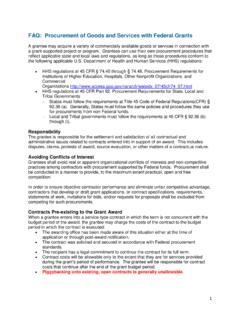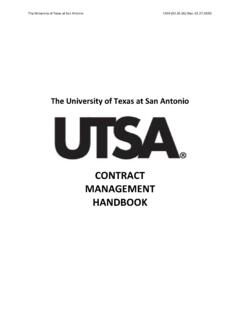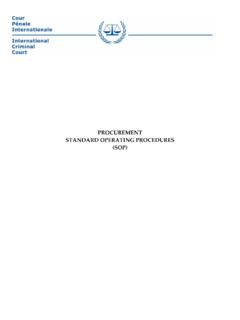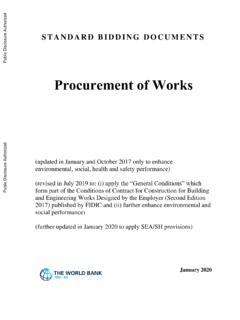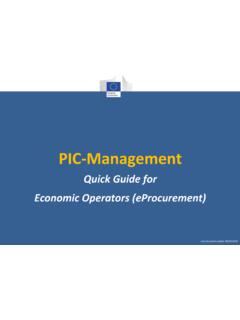Transcription of Annex 1 Procurement guidelines for tender preparation ...
1 Annex 1101 Annex 1 Procurement guidelines for tender preparation , evaluation and award of contractINTRODUCTIONAll Procurement (and planning) must conform to the three pillars of Integrity, Transparency and Accountability. These apply to all activities before construction, the actual construction (especially if consultants and contractors are to be used) and to the subsequent operation and maintenance of the structure and any related infrastructure such as an irrigation rules exist in most countries and for all international financing agencies and these must be followed. These rules should encourage true and open competition in tendering and contract award, open meetings and equitable and fair distribution of information, effective monitoring and auditing of all processes and implementation part of the preparation work, and before any tender is advertised, the procur-ing agency requires a realistic estimate (based on a good quality design and costing process) of the cost of the structure with a breakdown of significant cost items.
2 To prepare such an estimate, an engineer (The Engineer) should be selected and be appointed to not only carry out this preliminary work but continue to supervize the contractor and ensure all works are carried out according to the design and to the highest quality possible. This estimate must be kept strictly confidential and there should be no links between personnel having this knowledge and the bidders. Should the subsequent bidding result in bids received that vary greatly from this estimate, questions should be raised on the validity of the bids. Underestimates from bidders could lead to poor contract performance and the need for changes and variations as the contract proceeds and overestimates may suggest over pricing, cartel links or other unrealistic bidding. Decision-making criteria at all stages must be clear, justifiable and objective (with a written record where needed) with no room for discretion at any time, especially in the evaluation and comparison of the of bidders for significantly expensive contracts or a series of small contracts18 is recommended, but avoiding the possibility of establishing cartels.
3 This prequalification should be based on professional competence (staff and equip-ment), relevant experience, financial capability and integrity. Any contractor or consultant that has recent, relevant convictions or has been disbarred for irregu-18 Awarding contracts for a number of small dams in one area, or for one project as one overall contract, may result in economies of scale in mobilization, the use of plant and equipment and in supervision. Manual on small earth dams102lar, financial activities, or failure to complete contracts, should not be allowed to WORKThe preparation of tender and contract documents, including all survey and design work needed to prepare quantities and guideline costings, should take place in good time. If funds are to be sourced from international lending agencies or donors, their guidelines will have to be followed and examples of advertisements and documents from such organizations should be obtained at the beginning of this process.
4 preparation may require the application for land and water rights, environmental impact assessments plus any needed compensation or resettlement plans. These must be completed before the dam construction can be approved and allowed to many places, construction can only take place in the dry season when river levels are low, access to the site easier and moisture control for compaction possible. Thus, the design and tender process should take place in the rainy season and be timed to be completed by the beginning of the next dry season in time for mobi-lization of plant and equipment as the ground begins to dry out. Clearing access roads, felling and removing trees and stripping foundation areas is often best begun before the ground has completely dried out. The end of one rainy season and the start of the subsequent dry season are the best times for this.
5 ADVERTISEMENT OF THE TENDERA lways include a site visit in any tender advertisement and award procedure. The tender advertisement period has to take into account the need for approval (usually at the advertisement and award stages) from the lender or donor, the need to adhere to local or national government regulations and bureaucratic procedures , whether it will be advertised internationally, regionally or nationally and the scope of works. A tender for one small dam could be advertised nationally and potential tenderers given 6 to 8 weeks to respond, including site visits and collection of docu-ments. Thus, the tender period for this, including advertisement and evaluation could be around 12 series of dams being funded by one or more donors may require international advertisement with time for potential bidders to collect documents, make site visits and prepare timetables and bids (in their home countries).
6 Such a tender may require up to 20 weeks to complete with further time required for the winning bidder to more complicated the works and the size and number of dams to be built, the longer the tender process will take. guidelines to assist in the preparation of tender and contract documents, and in the award of a contract for a simple project involving only one or two small dams, are given below:The evaluation modalities (see details hereafter) or any modified equivalents are to be attached to every tender document to permit bidders to understand the proposed evaluation 1103 Always keep written records of significant events and always advise bidders in writing of any matter that could have legal implications. Any specific information given to any tenderer that is not in the documents should be passed on, in writing, to all other evaluation MODALITIESTwo options exist for tender , and the choice has to be indicated in the tender the first option, the technical and financial offer are combined and presented in a single envelope.
7 The second option, called staged tender , involves a two envelope system in which the technical proposal (first envelope) is evaluated and bids ranked before the financial offer (second envelope) is opened. It ensures that price does not influence the technical evaluation of the bid. This approach should be preferred, in particular in the case of complex contracts. Where a two envelope tendering process is used, it should be indicated in the tender document that tenderers are to place the technical and financial components of their tenders in separate, clearly marked, envelopes. These envelopes are to be placed inside a single envelope and normal procedures apply for the lodging of the tender . A points system should be adopted, based on criteria that can be adjusted accord-ing to country, individual dam sites, scope of work and other factors. All tenderers must be made aware of the evaluation procedure to be followed and whether there are any special conditions involved.
8 The following point system can be used as a guide:Technical bid: 50 pointsExperience 20 Points maximumThis is calculated according to the personal evaluation of each team member and considers the following: any experience (good or bad) with the contrac-tor, experience of the contractor in the area and in similar and Staff 10 Points maximumAgain individual team member evaluation is used. Factors such as numbers and age of equipment, suitability of equipment for the works involved, expe-rience of staff (including operators and supervisors) and support the contrac-tor has in country (including provision of fuel supplies, site accommodation, mechanical backup and so on) should be considered. Where labour intensive works are being promoted this category could be given more points (20 perhaps and the experience category reduced to 10) and those contractors offering to follow such procedures given the highest number of Programme 10 Points maximumHighest points are given to contractors who can complete the works within the already decided project time frame or before the next rainy season of Contractor 10 Points maximumBased on mobilization distance rather than physical location of the contrac-tor, this is also determined at the judgment of each team member.
9 As a guide, highest ( 10) points should be given to contractors located within the local area, then say 8 points for provincial locations, 4 points for nationally based contractors and 2 or less for contractors mobilizing from outside the on small earth dams104 Financial bid: 50 points Cost - 50 Points maximumThe lowest priced bid receives 50 points and other bids receive points based on 50 minus 1 point for every 2 percent difference from the lowest bid price. Any bids more than 100 percent higher than the lowest bid receive no evaluation An evaluation team of at least three people should be established. At least one person should have an engineering background (The Engineer is best selected for this) and be able to advise other team members on technical issues if they arise. Inclusion of a local (dam committee) person may also prove useful. A team of more than six may, however, be too cumbersome and thus inappro-priate.
10 Team members should avoid fraternization and other close contact with bidders at this following steps are to be followed:Step 1: RECEPTION OF THE BIDSF ollowing advertisement of the tender , ensure that every tenderer who pays the required, non-refundable, fee19 receives the documents, design drawings, quantities (but no guideline costs), any Community Agreement, the date of the site visit and details on where the tender documents are to be delivered, the deadline for delivery and the location and time of tender the deadline is changed, all potential tenderers must be advised either personally (if few in number) or by advertisement in the received should be noted in a diary and the bidder and staff member sign to confirm date and time received. Any bids delivered in unsealed envelopes should be rejected and the bidder advised in writing that his/her fee is forfeited and that s/he cannot re-bid.










